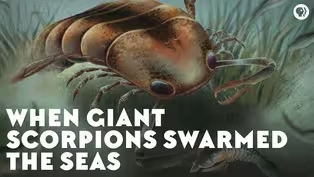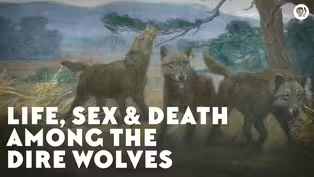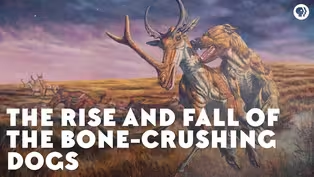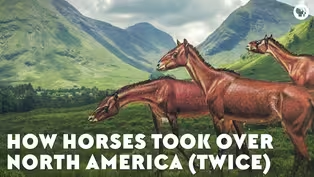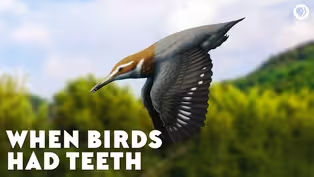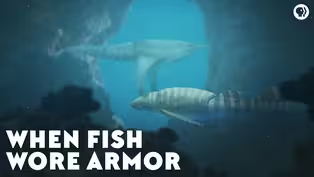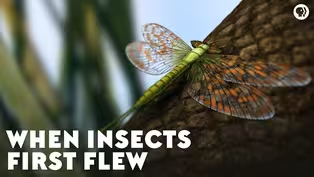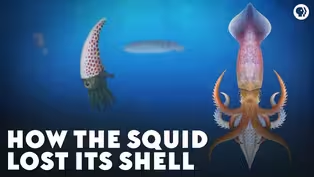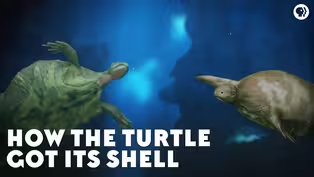
Why Triassic Animals Were Just the Weirdest
Season 1 Episode 44 | 9m 7sVideo has Closed Captions
Why the Triassic was full of creatures that look a lot like other, more modern species.
The Triassic was full of creatures that look a lot like other, more modern species, even though they’re not closely related at all. The reason for this has to do with how evolution works and with the timing of the Triassic itself: when life was trapped between two mass extinctions.
Problems playing video? | Closed Captioning Feedback
Problems playing video? | Closed Captioning Feedback

Why Triassic Animals Were Just the Weirdest
Season 1 Episode 44 | 9m 7sVideo has Closed Captions
The Triassic was full of creatures that look a lot like other, more modern species, even though they’re not closely related at all. The reason for this has to do with how evolution works and with the timing of the Triassic itself: when life was trapped between two mass extinctions.
Problems playing video? | Closed Captioning Feedback
How to Watch Eons
Eons is available to stream on pbs.org and the free PBS App, available on iPhone, Apple TV, Android TV, Android smartphones, Amazon Fire TV, Amazon Fire Tablet, Roku, Samsung Smart TV, and Vizio.
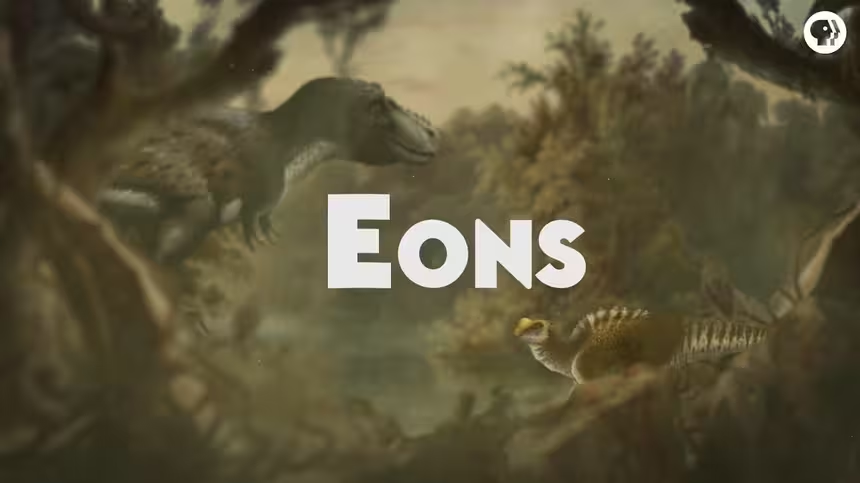
Welcome to Eons!
Join hosts Michelle Barboza-Ramirez, Kallie Moore, and Blake de Pastino as they take you on a journey through the history of life on Earth. From the dawn of life in the Archaean Eon through the Mesozoic Era — the so-called “Age of Dinosaurs” -- right up to the end of the most recent Ice Age.Providing Support for PBS.org
Learn Moreabout PBS online sponsorshipMore from This Collection
Ancient Fauna, Flora & Fungi
When Giant Scorpions Swarmed the Seas
Video has Closed Captions
Sea scorpions thrived for 200 million years, coming in a wide variety of shapes and sizes. (11m 38s)
Video has Closed Captions
A look at when Temnospondyls Amphibians existed for 210 million years (9m 51s)
Life, Sex & Death Among the Dire Wolves
Video has Closed Captions
Dire wolves were real! Their remains taught us a lot about how they lived. (9m 15s)
The Rise and Fall of the Bone-Crushing Dogs
Video has Closed Captions
What happened to the biggest dogs that ever lived? (8m 29s)
How Horses Took Over North America (Twice)
Video has Closed Captions
Horses vanished from North America for 10,000 years until a mammal brought them back. (9m 8s)
Video has Closed Captions
How did Archaeopteryx relate to today’s birds? Its teeth provide a major clue. (11m 29s)
Video has Closed Captions
420 million years ago, some fish wore armor – and it may have served a surprising purpose. (9m 37s)
Video has Closed Captions
Insects were the first animals to fly. Scientists are still working on how it happened. (8m 38s)
Video has Closed Captions
Before a group of fish could live on dry land, they acquired the ability to breathe air. (8m 40s)
Video has Closed Captions
Ancestors of cephalopods all had shells until it proved to be their biggest weakness. (8m 5s)
Video has Closed Captions
Where did turtles come from? And how did the they get their shells? (8m 29s)
Providing Support for PBS.org
Learn Moreabout PBS online sponsorship220 million years ago some strange-looking reptiles lived in the forests of northern Pangaea they kind of look like chameleons with grasping hands and feet and long prehensile tails but they also had really small bird-like heads and sometimes beaks and these cool spikes sticking out of the ends of their tails these were the japan-us oars and for a long time paleontologists didn't know what to make of them sure they look kind of like chameleons but their heads are all wrong not at all like other reptiles and chameleons don't show up in the fossil record for another hundred and twenty million years after these guys so for a long time some experts thought that these animals were close ancestors of birds I myself don't see it but it turns out the Triassic was full of animals like this creatures that look a lot like other more modern species even though they're not closely related to them at all in addition to the japan-us ores the Triassic was home to the phytosaurs which could easily be mistaken for crocodiles and ichthyosaurs which looked a whole lot like porpoises even though they were reptiles there was a host of creatures whose body plans would show up again and again much later in time by completely unrelated species so why are the animals of the Triassic like this what made them look like animals that lived much later and that they weren't related to the answer has to do is how evolution works in with the timing of the Triassic itself when life was trapped between two mass extinctions dhurpa no sores were unknown to scientists until the late 1970s when the first species Japan asaurus unyu aikka datas was named based on fossils found in Italy and since then only a handful of others have been named all from Triassic rocks in the northern hemisphere scientists originally thought that Japan s ores were just weird early lizards but the more they looked at them the more confusing they became these creatures had grasping hands arched backs and thick muscular tails some kinds like mega Lanco soros even had prehensile tails with a claw like hook on the end that helped them hold on to branches and the heads on these animals weren't like those on other reptiles they had pointed snouts big eyes and sometimes beaks instead of teeth making them look a lot less like lizards and more like featherless birds their necks were bird-like - with vertebrae that were saddle-shaped giving them a greater range of motion now because their heads and necks were so bird-like some researchers in the 90s thought chirp Ana Soares must have had something to do with the early evolution of birds themselves despite the fact that the rest of their bodies looked nothing like birds but in 2017 things started to become more clear when the pristine skull of a New Japan a source species was reported in New Mexico the new genus was named av cranium or bird head and it brought the relationship between Japan s ores and other reptiles into sharper focus it turned out that any resemblance this Turpan asur had to birds was pretty superficial its ears for instance lacked eardrums and were more like the ears of early reptiles than those of birds in fact researchers compared more than 300 of its anatomical features with other early reptiles and concluded that Japan asuras were one of the earliest branching lineages of reptiles probably diverging in the late permian period and like all early reptiles the ancestors of Japan Oh soars probably look superficially like lizards even though they weren't closely related to them they had short necks low slung bellies and long tails with limbs sticking out from the sides of the body so what happened to them how did Japan asuras go from being pretty familiar lizard like reptiles to animals so strange it took experts decades to figure out what they were and how did these changes happen in such a short span of time it's because the triassic was basically the meet in an extinction sandwich the entire Triassic period is a window of just 52 million years between two major extinction events at the early end there was the Great dying which eradicated about 70 percent of terrestrial species and 90% of marine life on the other end there was the aptly-named in Triassic extinction which wiped out more than half of all animal species but in between there was this whole wide still mostly livable world and for the survivors of the Great dying this was a completely different world one with a whole host of ecological niches that needed to be filled and at the same time there was almost no competition and in any given environment its competition that usually regulates the rate of evolutionary change among living thing by and large the less competition there is the faster the rate of change will appear to be that's because a lack of competition allows empty niches in an ecosystem to be filled by new species then over time as those niches fill up competition increases and the rate of evolutionary change appears to slow down I say it appears to because genetic mutations keep showing up like they always do but if those mutations don't offer big advantages right away they get weeded out and body plans keep looking basically the same so if you're an animal that's found your niche say preying on fish and rivers the natural selection tends to let you keep doing what you're doing your rate of evolutionary change at least hourly appears to be slow because you found a body plan that works likewise it's hard for other lineages to move into that role so natural selection usually leads them to keep doing what they're doing to rather than to try to compete directly for a niche that's already been filled but when extinctions occur the opposite happens lots of niches open up and there's much less competition there's plenty of room for everyone and that's when the rate of evolutionary change takes off organisms quickly move into unfilled niches and diversify into new species as they arrive at the adaptations that help them succeed in certain rules these explosive bursts of evolutionary change are known as adaptive radiations and they typically happen after mass extinctions and this is exactly what happened to Jo Soares and other reptiles at the start of the Triassic before the great dying in the Permian the ancestors of all reptiles look pretty lizard-like and they filled similar niches that many lizards do today but the earliest members of the japan-us or line started to adapt to a specific niche that of tree-climbing insectivores and within just 20 million years the first or panas ores appear in the fossil record as their own distinct lineage of reptile those chameleon like hands and feet help them climb trees the arch shoulders and flexible necks may have helped them catch bugs or peel away tree bark and their bird-like heads and beachy mouths allowed them to probe tight spaces for food as the Triassic wore on more empty niches were filled and the rate of evolutionary change and the appearance of new species slowed down soon a new normal was established for example some lineages of reptiles took on the role of apex predators on land and by 240 million years ago a group of arca soars the rise ooh kids appear in the fossil record meanwhile with these predators running around another line of plant-eating ARCA soars the AIDA soars came to be covered in bony armor and another lineage became adapted for catching fish these reptiles called phytosaurs developed long narrow snouts lined with teeth in just a few million years thanks in part to the lack of competition for the role of river dwelling fish eaters but you know what happens next starting around 201 million years ago a wave of volcanic activity along with pangaea's breakup released tons of co2 into the atmosphere causing rapid global warming and ocean acidification it brought it into the Triassic period and also the end of about three-quarters of the world's species including the AIDA soars phytosaurs and the drop Ana soars this time it was the dinosaurs who were the big winners because they were small and unspecialized which may have helped them survive and then they went on to fill the empty ecological niches that were once filled by the Triassic animals setting off a whole new round of adaptive radiation the AIDA soars for example were gone but Stegosaurus and ankylosaurus eventually took their play as armored herbivores likewise with the disappearance of the phytosaurs spinosaurus and crocodiles were able to move in to dominate as freshwater predators in fact most dinosaur groups replaced earlier species that had filled a similar niche and they often wound up repeating some of their body plans too a classic example of convergent evolution where similar selective pressures can lead to similar physical results and this whole cycle has repeated itself throughout history extinctions strike only to be followed by bursts of evolutionary innovation through adaptive radiation in fact after the non-avian dinosaurs were wiped out their surviving mammals and birds went through the same rapid bursts of evolutionary change filling the niches left empty by the dinosaurs even though the history of life is marked by devastating mass extinctions the survivors rally each time adaptive radiations produce a dizzying number of new species and body plans keep showing up molded as they are by the same selective pressures it's a pattern that will go on probably forever including after the next mass extinction as some guy once said life finds a way


- Science and Nature

A documentary series capturing the resilient work of female land stewards across the United States.












Support for PBS provided by:

